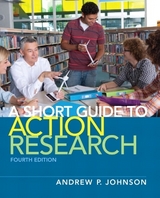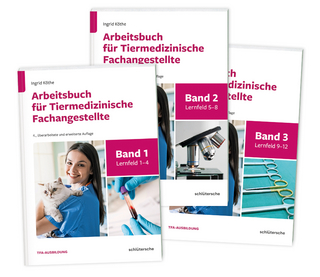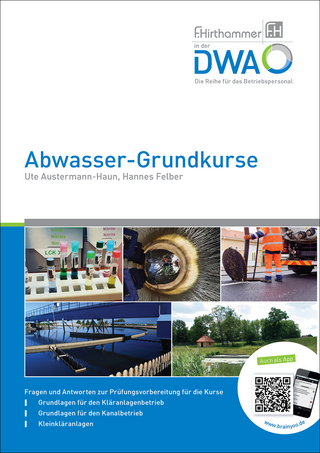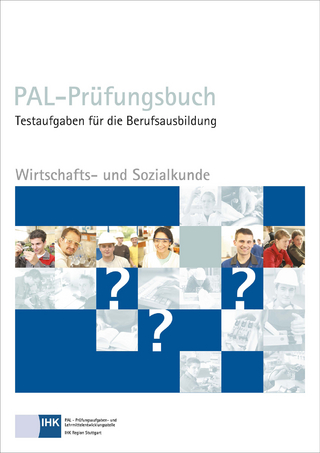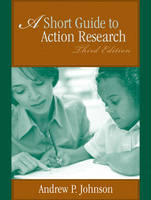
A Short Guide to Action Research
Pearson (Verlag)
978-0-205-50931-7 (ISBN)
- Titel erscheint in neuer Auflage
- Artikel merken
This book guides the learner through comprehension and interpretation of both qualitative and quantitative techniques in action research methods and then describes all phases of the process, including selecting a topic; collecting, analyzing, and reporting data; reviewing the literature; and presenting the report.
There are many new strategies and examples of projects that can be used for professional growth and development included with this edition, as well as more examples, ideas for possible research questions, & many new forms and graphics that have been added.
Andrew Johnson is Professor of Holistic Education in the Department of Educational Studies: Special Populations at Minnesota State University, Mankato. Here he specializes in gifted education, holistic education, literacy instruction, academic and professional writing, and spiritual intelligence. He worked for 9 years in the public schools as a second grade teacher, wrestling coach and as a gifted education coordinator before moving into higher education. His most recent books include Making Connections with Elementary and Middle School Social Studies published by Sage Publications and The Inner Curriculum: Classroom Activities to Develop Emotional Intelligence published by Royal Fireworks Press. He can be reached for comment at: andrew.johnson@mnsu.edu. For information related to workshops and professional development opportunities go to: www.teachergrowth.com
INTRODUCTION
Chapter I: Science, Research, and Teaching
1. SCIENCE
A. Science and Pseudoscience
2. RESEARCH
A. Quantitative Research
B. Qualitative Research
3. TEACHING
A. What Scientists and Teachers Do
3. USING RESEARCH IN EDUCATION: THEORIES, HYPOTHESES, AND PARADIGMS, OH MY!
A. Theories and Hypotheses.
B. Paradigms
Chapter II: Research Paradigms and the Nature of Reality
1. ONTOLOGICAL PERSPECTIVES
A. Materialistic Monism
B. Dualism
C. Transcendental Monism
D. Three Perspectives in Perspective
2. IMPLICATIONS
Chapter III: Introduction to Action Research
1. RESEARCH IN ACTION
A. A Quick Overview of Action Research
B. Descriptors of Action Research
2. THE IMPORTANCE OF ACTION RESEARCH
A. The Gap between Theory and Practice
B. Teacher Empowerment
C. Teacher Inservice and Professional Growth
Chapter IV: Using Action Research for Solving Problems
1. FINDING THE PROBLEM
2. FINDING SOLUTIONS
A. Creative Problem Solving
B. Means—End Analysis
C. Problem-Solving Strategies in the Classroom
3. TESTING THE SOLUTION
4. AN EXAMPLE OF ACTION RESEARCH AND PROBLEM SOLVING
A. Finding the Problem
B. Finding a Solution
Chapter V: Strategies for Professional Growth and Development
1. ACTION RESEARCH AND THE PROVESSIONAL DEVELOPMENT OF TEACHERS
A. More Knowledge Please
B. Process and Empowerment
C. Other Professional Development Opportunities
2. OBSERVING YOUR OWN PRACTICE
A. Best Practice
B. Descriptive, Not Prescriptive
3. FINAL WORD
Chapter VI: The Beginning
1. AN OVERVIEW OF THE ACTION RESEARCH PROCESS
A. Action Research Steps
2. FINDING YOUR RESEARCH TOPIC
A Teaching Strategy
B. Identify a Problem
C. Examine an Area of Interest
3. HAVING TROUBLE STARTING?
Chapter VII: A Theoretical Context
1. REVIEWING THE LITERATURE
2. SOURCES FOR THE LITERATURE REVIEW
A. Academic Journals
B. The Internet
C. Books
D. Nonprint Sources
E. How Many Sources?
3. SAMPLE LITERATURE REVIEWS
A Literature Review at the Beginning
A Literature Review at the End
Chapter VIII: Methods of Collecting Data
1. DATA COLLECTION
A. Systematic
B. Data Collection and Soil Samples
C. A Television Sports Analyst
2. TYPES OF DATA COLLECTION IN ACTION RESEARCH
A. Log or Research Journal
B. Field Notes–Your Observations
C. Checklists
D. Conferences and interviews
E. Video- and Audiotapes
F. Data Retrieval Charts
G. Rating Checklist
H. Students’ Products or Performances
I. Surveys
J. Attitude and Rating Scales
K. The Arts
L. Archival Data
Chapter IX: Methods of Analyzing Data
1. ACCURACY AND CREDIBILITY: THIS IS WHAT IS
2. VALIDITY, RELIABILITY, AND TRIANGULATION
A. Validity
B. Triangulation
C. Reliability
3. INDUCTIVE ANALYSIS
A. Larry, Moe, and Curly Help with Inductive Analysis
B. Case Studies or Representative Samples
C.Vision Quest
D. Defining and Describing Categories
Chapter X: Quantitative Design in Action Research
1. CORRELATIONAL RESEARCH
A. Correlation Coefficient
B. Misusing Correlational Research
C. Negative Correlation
D. Making Predictions
2. CAUSAL-COMPARATIVE RESEARCH
A. Whole Language in California
3. QUASI-EXPERIMENTAL RESEARCH
A. Quasi-Action Research
B. Pretest—Posttest Design
C. Pretest—Posttest Control Group Design
D. Time Series Design
E. Time Series Control Group Design
F. Equivalent Time-Sample Design
4. THE FUNCTION OF STATISTICS
A. Descriptive Statistics
B. Inferential Statistics
Chapter XI: Discussion: Your Plan of Action
1. CONCLUSIONS AND RECOMMENDATIONS
A. Christina Stolfa, Nacogdoches,.
B. Jo Henriksen, St. Louis Park, Minnesota
C. Cathy Stamps, Fifth Grade, Hopkins Elementary School
D. Delinda Whitley, Mt. Enterprise, Texas
2. EVALUTION OF THE STUDY
A. Staci Wilson, Irving Texas
3. DESIGNING A NEW PLAN OR PROGRAM
A. Creating a New Plan or Program
B. A Less Formal Plan of Action
Chapter XII: Sample Action Research Projects
A. Alison Reynolds, Minneapolis, Minnesota
B. Kay Dicke, Eden Prairie
C. LouAnn Strachota
D. Georgina L. Pete
E. Teresa Van Batavia, Eisenhower Elementary, Hopkins, Minnesota
F. Linda Roth, St. Peter School District, St. Peter, Minnesota
G. Angela Hassett Brunelle Getty, Martinez, California
H. Michelle Bahr, Shakopee, Minnesota
I. Kim Schafer, Minnetonka, Minnesota
Chapter XIII: Presenting Your Action Research
1. THE EDUCATIONAL ENVIRONMENT
A. Your Colleagues
B. Your Students
C. School Boards, Principals, and Administrators: Making a Case
E. Your Classroom: Evaluating New Programs
F. Parent Conferences
G. As Part of a Masters Thesis
2. THE PROFESSIONAL ENVIRONMENT
A. Professional Conferences and Conventions
B. Academic Journal
C. ERIC
3. LOCAL COMMUNITY ORGANIZATIONS
Chapter XIV: Writing an Action Research Report
1. TONE AND STYLE
2. LENGTH
3. CLARITY
4. HEADINGS
Chapter XV: Action Research as Master’s Thesis
1. BEFORE YOU START
a. Nine Tips for Writing Your Master’s Thesis
2. THE ACTION RESEARCH THESIS
3. EXAMPLES OF FULL MASTERS THESES
A. Christine Reed, Educational Specialist Degree, Nerstrand Elementary School, Nerstrand Minnesota.
B. Jackie Royer, Masters Thesis, Trimont Schools, Trimont, Minnesota
4. THE LAST WORD
Chapter XVI: The Literature Review
1. A THEORETICAL CONTEXT
A. Steps for a Literature Review
2. A SAMPLE LITERATURE REVIEW
3. THE REFERENCE PAGE
Chapter XVII: Findings: Reporting Qualitative Data
1. PRESENTING QUALITATIVE DATA
2. THE IMPORTANCE OF STRUCTURE
A. Structure and Inductive Analysis
B. Using Headings to Create Structure
C. Using Subheadings to Create More Structure
3. CASE STUDIES OR REPRESENTATIVE SAMPLES
A. It’s Alive!
4. APPENDICES
Chapter XVIII: Findings: Reporting Quantitative Data Using Tables, Figures, and Graphs
1. QUANTIFYING REALITY
A. Using Numbers
B. Using Words
C. Reporting Arithmetic Data
3. TABLES
4. FIGURES
A. Graphs
B. Other Visuals
EPILOGUE
| Erscheint lt. Verlag | 2.2.2007 |
|---|---|
| Sprache | englisch |
| Maße | 236 x 178 mm |
| Gewicht | 399 g |
| Themenwelt | Sozialwissenschaften ► Pädagogik ► Berufspädagogik |
| Sozialwissenschaften ► Soziologie ► Empirische Sozialforschung | |
| ISBN-10 | 0-205-50931-2 / 0205509312 |
| ISBN-13 | 978-0-205-50931-7 / 9780205509317 |
| Zustand | Neuware |
| Informationen gemäß Produktsicherheitsverordnung (GPSR) | |
| Haben Sie eine Frage zum Produkt? |
aus dem Bereich
